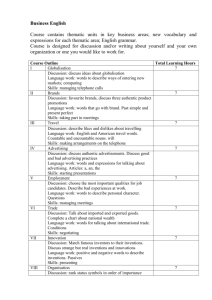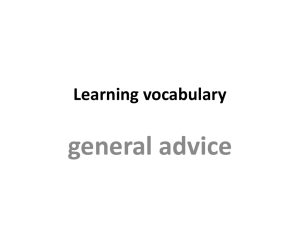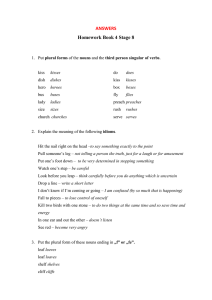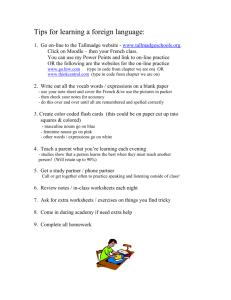principles1
advertisement
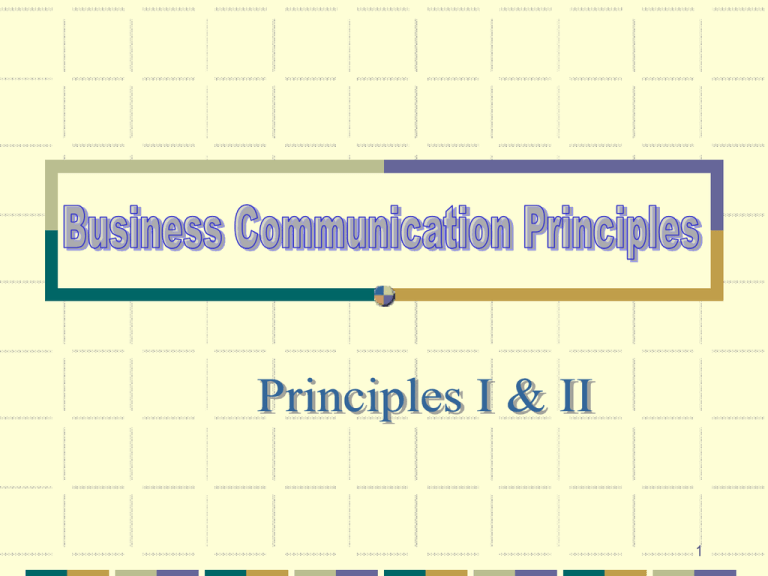
1 Principles I To compose effective messages, we need to apply certain principles. They provide guidelines for choice of content and style of presentation- adapted to the purpose and receiver of the message. Completeness. Conciseness Consideration Concreteness 2 Completeness. Answer all questions asked. Give something extra, when desirable. Check for the five “W’s ” questions- Who, What, When, Where, Why and any other essentials such as how. 3 Answer all questions asked. Whenever you reply to inquiry, try to answer all questions-stated and imply. The reaction of the recipient to incomplete reply is likely to be unfavorable. The recipient may think the respondent is careless or is purposely trying to conceal a weak spot. If you have no information on a particular question, say so clearly. If you have unfavorable information in answer to questions, handle your reply with tact and honesty. 4 Give something extra, when desirable. ● ● ● The word when desirable is essential. Sometimes you must do more than answer the senders’ specific questions. They may not know what they need, or their questions may be inadequate. For example, suppose you received the following inquiry letter from an out-of-town member. I think I would like to attend my first meeting of the league, even though, I am not acquainted in your city. Will you please tell me where the next meeting will be held. ● If you answered only this one question, your letter would be incomplete. Realizing that your reader is a newcomer to your city and to your meeting, you should include in your reply a welcome plus such needed details as directions for reaching the building; parking facilities; day, date, and time of the meeting and maybe the program for the next meeting. 5 Check for the five “W’s ” questions- Who, What, When, Where, Why and any other essentials such as how. ● Another way to help make your message complete is to answer, whenever desirable, the five “W’s” questions. ● This method is useful when you write requests, announcements, or other informative messages. For instance, to order merchandise, make clear what you want, when you need it, to whom and where it is to be sent, and how payment will be made. 6 Conciseness Eliminate wordy expressions. Include only relevant statements. Avoid unnecessary repetition. 7 Eliminate wordy expressions. ● use single-word substitutes instead of phrases whenever possible without changing meaning. For example, Wordy expression at this time due to the fact that for the purpose that Concise now because for; to 8 in order to to from the point of view as in the most cases usually in spite of the fact that although during the time that while please do not hesitate to write please write 9 Include only relevant statements. ● Be sure to include relevant fact, stick to the purpose of the message, omit information obvious to the receiver, and avoid long introductions and unnecessary explanations. 10 Avoid unnecessary repetition. ● Sometimes repetition is necessary for emphasis. But when the same thing is said two or more without any reason, the message become wordy and boring. For instance, use a shorter name after you have mentioned the long one once. Use initials rather than repeat long name. King Saud University. KSU 11 Consideration Focus on “You” instead of “I” and “We”. Show reader benefit or interest in reader. Emphasize the positive, pleasant facts. Apply integrity and ethics. 12 Focus on “You” instead of “I” and “We”. ● Your receivers are usually more concern about themselves than about you or your company. ● They are more likely to read your message when they see their name and the pronoun “you” rather than “I” “we” or us. For example, we will ship soon the goods in your May 4 order. “I”, “we” attitude. It is better to write. You should receive by may 8 the Apex screens you ordered may 4. “you” attitude. 13 Show reader benefit or interest in reader. ● Whenever possible and true, show how readers will benefit from whatever the message asks or announces. ● They will be more likely to react favorably and do what you suggest if you show that benefits are worth the effort and cost. For example, you will be glad to know that we now have a walk-up window open 8-12 a.m. and 4-8 p.m. every weekday. ● The following message shows the reader’s benefit. You can now take care of your banking needs also at our new walkup window. It is open with a capable teller to serve you 8-12 a.m. and 4-8 p.m. Saturday through Wednesday. 14 Emphasize the positive, pleasant facts. ● This means stressing what can be done instead of what cannot be done and focusing on words your recipient can consider favorably. ● For most people negative words like no, cannot, never, impossible trigger unpleasant emotional reactions. ● By making clear what you can or will do, you (by implication) often make clear what you cannot do, without using a single negative word. For example, it is impossible to open an account for you today. “negativeunpleasant”. As soon as your signature card reaches us, we will gladly open an account… “positive-pleasant”. 15 Apply integrity and ethics. ● We also need to apply integrity-high moral standard, personal honor, truthfulness, sincerity to our written messages. ● without “integrity”, business communication would prove worthless, and our confidence in people would be shattered. ● Ethics is concerned with what is right human conduct. ● Codes of ethics provide standards enabling us to determine the fundamental distinction between right and wrong human behaviour. 16 Concreteness Use specific facts and figures. put an action in your verbs. Choose vivid, image-building words. 17 Use specific facts and figures. ● Whenever you can, substitute an exact statement or a figure for a general word to make your message more concrete and convincing. For example, this computer reproduces campaign letters fast. “ vague and general”. this computer types 400 personalized 150-word campaign letters in one hour. “concrete and convincing”. 18 put an action in your verbs. ● Strong verbs can activate other words and help to make your sentences definite. ● To compose strong sentences, you should use active rather than passive verbs. For example, a full report will be sent to you by the supervisor. “passive voice”. The supervisor will send you a full report. “active voice”. ● Put an action in your verbs instead of in nouns. Seven verbs- be, give, have, hold, make, put, and take might be designated as “deadly” verbs. ● when the action they introduce is hidden in a “quiet noun”. For example, Mr. Omer will give consideration to the report. “action hiding in a Quiet Noun”. Mr. Omer will consider the report. “action in the verb”. 19 Choose vivid, image-building words. ● Among the devices you can use to make your message forceful, vivid, and specific are comparison, figurative language, and concrete instead of abstract nouns, and well-chosen adjectives and adverbs. “Comparisons” . Help the recipient to build meaningful picture. For instance, this is pure clover honey, made by honeybees. “Vague” . Honeybees have gathered nectar from approximately 4½ million clusters of clover and traveled about 150,000 miles or equal to six times around the world to deliver this package of Bradshaw honey to you. “Vivid” 20 ● Figurative language. Figures of speech may express an idea more vividly than literal language. For example, X product helps you to lose your double chin in four weeks, if you use X as directed. “literal”. If two chins quarrel for a place on your collar, X product helps settle the argument. Only one chin remains after you use X just four weeks as directed. “figurative”. ● Concrete nouns instead of abstract nouns. Concrete nouns represent subjects your recipient can touch, see, smell, hear, or taste. Abstract nouns as subjects designate intangible concepts. They bring only vague “pictures” to the person’s mind. for example, consideration was given to the fact that…“abstract”. The committee considered the fact that… “concrete”. 21 Business Communication Principles II To make our messages easily understood, friendly, and accurate we should also apply the remaining “C” principles. Clarity Courtesy Correctness 22 Clarity Choose short, familiar, conversational words Construct effective sentences and paragraphs. Achieve appropriate readability Include example, illustrations, and visual aids, when desirable. 23 Choose short, familiar, conversational words ● Use short word instead of long one, use familiar word that the reader can easily understand. For example, use the words after, not subsequent. Pay, not remuneration. announce or declare, not promulgate…etc. ● Avoid technical and business jargon whenever possible. If you must use them, define them. 24 Construct effective sentences and paragraphs. ● Important characteristics to consider are length, unity, coherence, and emphasis. ● For length, It is better to use short sentence. The suggested sentence length about 17-20 words. The general rule in business writing is to keep paragraphs as short as possible. The first and last paragraph of a letter and memo should preferably be kept to no more than four or five lines. ● For unity to express main idea, unity means that you have one main idea regardless of sentence structure (simple, compound, or complex). 25 ● Coherence, for clear meaning. In a coherent sentence, the words are correctly arranged so that the ideas clearly express the intended meaning. ● Place the correct modifier as close as possible to the word it is supposed to modify. For example, his report was about managers, broken down by age and sex. “unclear”. His report focused on age and sex of managers. “clear”. Ali could not drive to work in his car with a broken leg “unclear”. 26 ● Emphasis, for forceful, clear expression. The quality that gives force to important parts of sentences and paragraphs is emphasis. Writers must decide what needs emphasis, and then choose correct sentence structure. In a complex sentence the main idea should be placed in the main clause, and the less important points are in the dependent clause. For example, the airplane finally approached the speed of sound, and it became very difficult to control. In this sentence the two ideas have equal value. “ no emphasis”. ● if the important idea is that “the airplane was difficult to control”. The sentence must be as the following. As it finally approached the speed of sound, the airplane became very difficult to control. “emphasis” the main idea is in the main clause. 27 Achieve appropriate readability ● In this case, You should adapt your business letters so that their word-and-sentence level will be appropriate for your recipients’ general education level. From “Fog Index Guide”, two factors measure your letters readability: sentence length and percentage of hard words. This index helps you to determine the educational level of your writer. For instance, if you have a letter, you can determine the educational level of the writer: first find the average sentence length by dividing the number of words by the number of sentences. Secondly, find the percentage of hard words by dividing the number of hard words by the number of words. Finally, multiply the total of the two equations by 0.4. the result is the measuring of the educational level of the writer. 28 Include example, illustrations, and visual aids, when desirable ● When you have complicated or lengthy explanation in letter or report, you can improve the clarity by giving your recipients an example, analogy, or illustration. ● Furthermore, visual aids-such as headings, tabulations, itemizations, pictures, charts-are definite aids to clarity and easy understanding. ● Also, typographical aids can be useful. Some important statements may be underlined, numbered, colored, or typed in all CAPITALS or italics or on short lines with wider margins. 29 Courtesy Be sincerely tactful, thoughtful, and appreciative. Omit expressions that irritate, hurt, or belittle. Grant and apologize good-naturedly. 30 Be sincerely tactful, thoughtful, and appreciative. ● Tact instead of bluntness. For example, your letter is not clear at all; I cannot understand it. “Tactless, Blunt” If I understand your letter correctly,... “Tactful” 31 Omit expressions that irritate, hurt, or belittle. ● Irritate expressions that should be avoided, particularly when used with “you” and “your”. Expressions such as I do not agree with you, irresponsible, we do not believe, we find it difficult to believe that, obviously you overlooked, you failed to, you leave us no choice, you should know...etc. ● Also you should avoid talking down to “belittling” to a person, it is considered to be a form of discourtesy. 32 Grant and apologize good-naturedly. ● Whenever you grant a customer’s request, begin your letter with the best news first and inject a courteous, ungrudging tone. If a request has caused you extra work, you may tactfully tell the customer somewhere in the letter but not the first paragraph. ● Occasionally, you may get a “nasty” letter from a customer who is wrong in his or her accusation. A courteous reply can lead not only to an apology from the customer but also to future staunch loyalty as a booster for your company. 33 Correctness Use the right level of language. Check accuracy of figures, facts, and words. Maintain acceptable writing mechanics. Choose nondiscriminatory expressions. Apply all other pertinent C qualities. 34 Use the right level of language. ● ● The three levels of language-formal, informal, and substandard- overlap because of our ever-changing language. The first two-formal and informal language are both correct, but they are different from one another, have different uses, and should not be interchange. The formal language is used for writing legal documents, academic researches…etc,. The expressions used are long, un-conversational, and impersonal. In contrast, the informal level refers to business language-for letters, reports, and newspapers…etc,. The expressions used are short, well-known, and conversational. The following list is an example of formal and informal level: formal informal anticipate expect endeavor try utilize use terminate end 35 interrogate ask Check accuracy of figures, facts, and words. ● Absolute accuracy is essential for effective written messages. When figures, facts, and words are incorrectly used, they can cause serious problems. ● In English, some words are often confused. The following are a few of many words that are often confused in usage: (a, an), (anxious, eager), (between, among), (biannually, biennially), (continual, continuous), (counsel, council), (effect, affect), (eminent, imminent), (imply, infer), (lay, laid, laid; lie, lay, lain), (principal, principle), (which, that, who), (who, whom). 36 Maintain acceptable writing mechanics. ● This includes correct punctuation, capitalization, syllabication, and spelling- plus correct sentence and paragraph structure. It also includes using correct format for letters, memos, reports, and envelopes. ● Two common weaknesses in writing mechanics deserve special mention: incorrect spelling and careless omissions. The careless omission refers to omissions of punctuation marks or words needed for grammatical accuracy. 37 Choose nondiscriminatory expressions. ● Another important requirement for correctness is “equal treatment of the sexes” and non-bias toward people of different races, ethnic origins, and physical features. ● Try to choose nondiscriminatory language when you refer to occupational roles and achievements, personal characteristics, physical and mental attributes, humanity at large, names, and various title designations 38 Apply all other pertinent C qualities. The End 39

